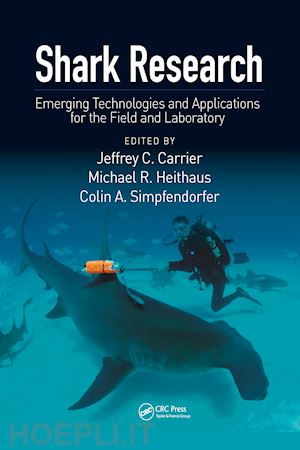Chapter 1 Dietary Biomarkers in Shark Foraging and Movement Ecology [Samantha E.M. Munroe, Lauren Meyer, and Michael R. Heithaus] Chapter 2 Size-Based Insights into the Ecosystem Role of Sharks and Rays [Nicholas K. Dulvy and Rowan Trebilco] Chapter 3 Advances in the Application of High-Resolution Biologgers to Elasmobranch Fishes [Nicholas M. Whitney, Karissa O. Lear, Adrian C. Gleiss, Nicholas Payne, and Connor F. White] Chapter 4 Using Aerial Surveys to Investigate the Distribution, Abundance, and Behavior of Sharks and Rays [Jeremy J. Kiszka and Michael R. Heithaus] Chapter 5 Animal-Borne Video Cameras and Their Use to Study Shark Ecology and Conservation [Yannis P. Papastamatiou, Carl G. Meyer, Yuuki Y. Watanabe, and Michael R. Heithaus] Chapter 6 Use of Autonomous Vehicles for Tracking and Surveying of Acoustically Tagged Elasmobranchs [Christopher G. Lowe, Connor F. White, and Christopher M. Clark] Chapter 7 The Use of Stationary Underwater Video for Sampling Sharks [Euan S. Harvey, Julia Santana-Garcon, Jordan Goetze, Benjamin J. Saunders, and Mike Cappo] Chapter 8 Acoustic Telemetry [Michelle R. Heupel, Steven T. Kessel, Jordan K. Matley, and Colin A. Simpfendorfer] Chapter 9 Imaging Technologies in the Field and Laboratory [Kara E. Yopak, Jeffrey C. Carrier, and Adam P. Summers] Chapter 10 History and Mystery of Age and Growth Studies in Elasmobranchs: Common Methods and Room for Improvement [Lisa J. Natanson, Allen H. Andrews, Michelle S. Passerotti, Sabine P. Wintner] Chapter 11 Near-Infrared Spectroscopy for Shark Ageing and Biology [Cassandra L. Rigby, William J. Foley, and Colin A. Simpfendorfer] Chapter 12 Photographic Identification of Sharks [Simon J. Pierce, Jason Holmberg, Alison A. Kock, and Andrea D. Marshall] Chapter 13 Genetics and Genomics for Fundamental and Applied Research on Elasmobranchs [Jennifer R. Ovenden, Christine Dudgeon, Pierre Feutry, Kevin Feldheim, and Gregory E. Maes] Chapter 14 Environmental DNA (eDNA): A Valuable Tool for Ecological Inference and Management of Sharks and Their Relatives [Agnes Le Port, Judith Bakker, Madalyn K. Cooper, Roger Huerlimann, and Stefano Mariani] Chapter 15 Shark CSI·The Application of DNA Forensics to Elasmobranch Conservation [Diego Cardeñosa and Demian D. Chapman] Chapter 16 Citizen Science in Shark and Ray Research and Conservation: Strengths, Opportunities, Considerations, and Pitfalls [Andrew Chin and Gretta Pecl] Chapter 17 Social Science and Its Application to the Studies of Shark Biology [Karin Gerhardt, Amy Diedrich, and Vanessa Jaiteh] Chapter 18 Network Analysis and Theory in Shark Ecology·Methods and Applications [Johann Mourier, Elodie Lédée, Tristan Guttridge, and David M.P. Jacoby] Chapter 19 Satellite Tracking Technologies and Their Application to Shark Movement Ecology [Luciana C. Ferreira, Kate L. Mansfield, Michele Thums, and Mark G. Meekan]











